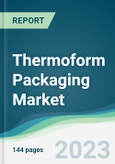The thermoform packaging market is expected to grow at a CAGR of 6.03% from US$35.118 billion in 2021 to US$52.91 billion in 2028.
Thermoform plastic packaging refers to a manufacturing process and packaging technique used to create custom-designed packaging solutions. It involves heating a thermoplastic sheet to a pliable temperature and then forming it into a specific shape using a mold or die. Once the material cools and hardens, it retains the desired shape and provides protective packaging for various products. Thermoform plastic packaging is used across various industries, including food and beverage, pharmaceuticals, electronics, cosmetics, and consumer goods.Market Overview:
The thermoform packaging market refers to the industry involved in the production and distribution of packaging solutions made from thermoformable plastic materials. Thermoform plastic packaging utilizes heat and pressure to shape thermoplastic sheets into various customized forms such as trays, containers, clamshells, and blister packs. This market is driven by factors such as the growing demand for visually appealing and cost-effective packaging, product protection requirements, customization options, and sustainability considerations. Thermoform plastic packaging finds applications across various industries, including food and beverage, pharmaceuticals, electronics, cosmetics, and consumer goods.Market Drivers:
- Product Protection:
- Customization and Versatility:
- Cost-Effectiveness:
- Sustainability and Recycling:
- Product Visibility, Convenience and User-Friendly Design:
It can be designed with features that enhance convenience for consumers. Easy-open mechanisms, resalable closures, and ergonomic designs contribute to user-friendliness and product usability.
- Shelf Life Extension:
- Lightweight and Space-Efficient:
- Compliance with Safety Standards:
Market Players:
- Amcor:Thermoform plastic packaging products by the company arerecyclable and compostable plastic material that is made from plant-based materials. It is a good alternative to traditional plastics, as it can be recycled into new products or composted into soil. Amcor has launched several thermoformed plastic packaging products made from Eco-Flex, including clamshells for food products and trays for beverages.
- Huhtamaki:Thermoformed packaging by the firm is a good alternative to traditional plastics, as it does not release harmful toxins into the environment when it breaks down.
Positive growth in the food and beverage segment:
The segment that is experiencing positive growth in the thermoform packaging market is the food and beverage industry. This growth can be attributed to several factors. Firstly, the increasing demand for convenience foods and ready-to-eat meals has led to a surge in the need for lightweight, portable, and easy-to-use packaging solutions that provide product protection and maintain food freshness. Secondly, the rising popularity of online food delivery services and e-commerce has created a demand for packaging that can withstand the rigors of transportation while ensuring food safety. Additionally, the industry's focus on sustainability has prompted the adoption of recyclable and eco-friendly thermoform packaging materials, meeting consumer expectations for environmentally conscious packaging solutions.The North American region is expected to hold a significant share:
North America is expected to witness a steady CAGR in the thermoform packaging market. This can be attributed to several factors, including the region's well-established food and beverage industry, growing consumer demand for convenience packaging, and the presence of major players in the packaging sector. Additionally, the region's focus on sustainability and the adoption of eco-friendly packaging solutions align with the growing market trend. Furthermore, the increasing e-commerce activities and the need for robust packaging for online shipments further contribute to North America's market share in the thermoform packaging market.Market developments:
- In Feb 2023,Neste and ILLIG formed a strategic partnership to promote more sustainable solutions in thermoformed plastic packaging production through demonstration cases. The collaboration aims to validate the use of renewable and recycled materials in demanding applications by recreating value chains on a small scale.
- In May 2022,MULTIVAC launched the R3 thermoforming packaging machine which is designed to run recyclable and environmentally friendly mono films, making it a sustainable option for food manufacturers. The R3 is also modular and easy to adapt to a wide range of customer requirements, making it a versatile and cost-effective choice.
Key Segment:
By Material
- Plastic
- Paper
By Product Type
- Blisters
- Clamshells
- Trays & Lids
- Containers
By End-user Industry
- Food & Beverage
- Pharmaceuticals
- Personal Care & Cosmetics
- Consumer Electronics
By Geography
- North America
- United States
- Canada
- Mexico
- South America
- Brazil
- Argentina
- Others
- Europe
- United Kingdom
- Germany
- France
- Italy
- Spain
- Others
- Middle East and Africa
- Saudi Arabia
- UAE
- Others
- Asia Pacific
- Japan
- China
- India
- South Korea
- Taiwan
- Thailand
- Indonesia
- Others
Table of Contents
1. INTRODUCTION
2. RESEARCH METHODOLOGY
3. EXECUTIVE SUMMARY
4. MARKET DYNAMICS
5. THERMOFORM PACKAGING MARKET, BY MATERIAL
6. THERMOFORM PACKAGING MARKET, BY PRODUCT TYPE
7. THERMOFORM PACKAGING MARKET, BY END-USER INDUSTRY
8. THERMOFORM PACKAGING MARKET, BY GEOGRAPHY
9. COMPETITIVE ENVIRONMENT AND ANALYSIS
10. COMPANY PROFILES
Companies Mentioned
- Amcor Plc
- Sonoco Products Company
- DS Smith
- Placon
- Display Pack
- WestRock Company
- Tekni-Plex, Inc.
- Anchor Packaging LLC
- D&W Fine Pack
- Sealed Air
Methodology

LOADING...
Table Information
| Report Attribute | Details |
|---|---|
| No. of Pages | 144 |
| Published | December 2023 |
| Forecast Period | 2021 - 2028 |
| Estimated Market Value ( USD | $ 35.12 Billion |
| Forecasted Market Value ( USD | $ 52.91 Billion |
| Compound Annual Growth Rate | 6.0% |
| Regions Covered | Global |
| No. of Companies Mentioned | 10 |









